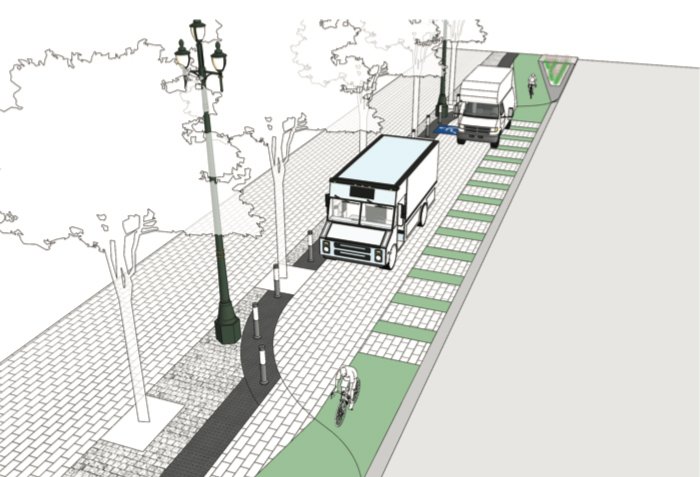A redesign for the first phase of San Francisco’s Better Market Street project is drawing ire from supervisors and advocates.
Christina Olea, of the Department of Public Works and Better Market Street project manager, Tuesday shared the revised design for the Fifth through Eighth streets portion, which eliminates a sidewalk-level bike lane. Plans that allowed Muni service to use the curb lane were also dropped. As currently designed, all Muni bus service will moved into the center lane.
The project, which has been in the works for years, was celebrated earlier this year by officials and advocates when The City utilized the “quick build” option to launch the car-free portion of the plan, prohibiting private vehicles from entering the busy downtown corridor.
Organizations including the San Francisco Bicycle Coalition, San Francisco Transit Riders and Walk San Francisco had heavily advocated for Better Market Street. Those organizations now question whether the redesign reduces safety benefits for cyclists, public transit riders and pedestrians.

Cat Carter, interim executive director of the San Francisco Transit Riders, said moving Muni service to the center lane does not make sense for service efficiency reasons, adding:
“We’re going to need more transit capacity on Market Street, not less.”
Tweet this!
Supervisor Dean Preston, who sits on the San Francisco County Transportation Authority board, said he too is worried that moving operations into the center lane could cause bus service to bunch.
On dropping the sidewalk-level bike lane, city staff said that bike volume significantly increased along Market Street after the corridor went car-free. Olea said the 8-foot bike path would be too narrow and in some cases would narrow further from between 5 to 6 feet due to loading zones, curbside Muni transit stops and a BART/Muni station entrance.
Instead, planners are using the existing curb lane for cyclists, commercial vehicles and taxis with painted double green sharrow markings and making the lane 11 feet wide.
Janice Li, the advocacy director for the San Francisco Bicycle Coalition, said the lack of separation from delivery vehicles and taxis from cyclists is unsafe. She said:
“The bike coalition is not asking for returns with the original proposal right now. What we are asking for is a right-sized design to deliver safety benefits and public goods that the public is on board with and this proposal isn’t there yet.”
Tweet this!
Advocates say they acknowledge cost restraints the project is currently experiencing, but said even with the redesign, the project will still run $121 million. The estimated price tag on the original design was $191 million. Li asked:
“Are we really getting $100 million in benefits?”
Tweet this!

Supervisor Matt Haney said excitement over the project has turned into dismay and he wants to ensure city staff continue public outreach efforts.
Haney said:
“When this project was approved, initially, it was met with widespread celebration and joy by people who rely on those modes of transportation. Unfortunately, they are meeting this current plan with quite the opposite of that.”
Tweet this!
Walk San Francisco’s Vision Zero Organizer Brian Haagsman said the group is concerned by the current outreach process, adding:
“We’re being shown one version of the new plan for only three blocks on a very rushed timeline.”
Tweet this!
Olea said city staff are planning several online virtual open houses in November and two virtual meetings. More information about the meetings can found on the Better Market Street project website.
Jerold serves as a reporter and San Francisco Bureau Chief for SFBay covering transportation and occasionally City Hall and the Mayor's Office in San Francisco. His work on transportation has been recognized by the San Francisco Press Club. Born and raised in San Francisco, he graduated from San Francisco State University with a degree in journalism. Jerold previously wrote for the San Francisco Public Press, a nonprofit, noncommercial news organization. When not reporting, you can find Jerold taking Muni to check out new places to eat in the city.
